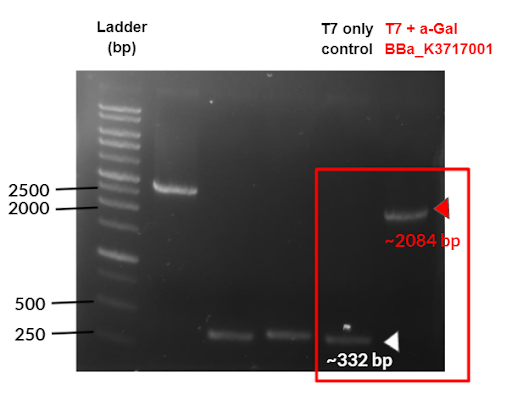Part:BBa_K3717001
α-Galactosidase with T7 promoter and strong RBS

Figure 1: α-galactosidase from 2014 Tuebingen with T7 promoter + RBS
Construct Design
α-Galactosidase is an enzyme that catalyzes the cleavage of the galactose off of B type blood antigens such that the remaining sugar can be classified as a H antigen, which the anti-A and anti-B antibodies are unable to recognize and thus does not elicit an immune response in the human body [1]. Thus, the enzyme can convert B blood types to universal O type.
We obtained the amino acid sequence of the α-Galactosidase protein, derived from Bacteroides fragilis, from the iGEM DNA Repository Plate (BBa_K1483002), which served as our Open Reading Frame (ORF). We attached a T7 promoter, derived from the T7 phage, and strong ribosome binding site (RBS; BBa_K525998) upstream of the open reading frame (ORF). The composite gene was synthesized through DNA cloning.
Results
In order to test protein expression of the enzyme, we added a T7 promoter and strong ribosome binding site (RBS;BBa_K525998) upstream of the protein amino acid sequence to create a part BBa_K3717001.

Figure 2 - Colony PCR check for T7 promoter α-Galactosidase (α-Gal) (Part: BBa_K3717001) using VF2 and VR primers. Uncut plasmid (T7 only control) has a band at the expected part size of 332bp, indicated by white triangle. Confirms successful ligation as a band is produced at the expected size of 2084bp, indicated by the red triangle.
We tested protein expression of this composite part by transforming our plasmids into BL21 E. coli cells. We grew cultures at 37°C overnight, diluted those cultures, and then grew to OD600 0.5~0.6 at 37°C. We then induced expression with 0.5 mM IPTG and allowed cultures to grow overnight at room temperature. We took samples pre-induction and post-induction and examined them by SDS-PAGE.

Figure 3 - SDS Page of cell lysate for the strain: T7 promoter α-Galactosidase (α-Gal) (Part: BBa_K3717001). Green triangles indicate expected size for α-Gal (65.7 kDa). We found that the sequences for the target proteins do not contain a start codon, thus have no expression, as shown by the triangles.
Our SDS-page (Fig. 3) did not show any overexpression bands for the enzymes of interest. The results indicate that there were no target proteins at their expected band sizes: 65.7 kDa band for T7 promoter + α-Gal in the induced sample. As the SDS page is of cell lysis samples, other bands present are due to innate proteins present in the bacteria cell.
Upon comparison of the amino acid sequence from Tuebingen’s part (BBa_K1483002) with full sequences that were offered by other studies online, we discovered that the enzyme sequences were missing a few amino acids, also including the start codon, which explained the non-expression of the proteins (Fig. 4).

Figure 4 - Top sequence: First 24 amino acids of Team Tuebingen's 2014 α-Galactosidase part BBa_K1483002. Bottom sequence: First 60 amino acids of TAS_Taipei'sα-Galactosidase part BBa_K3717006; the first 15 amino acids include a 6x His tag and linker used for purification. Based on the alignment of the two sequences, Tuebingen's part is missing the first 21 amino acids of the α-Galactosidase protein.
References
1. Rahfeld, Peter, and Stephen G. Withers. “Toward Universal Donor Blood: Enzymatic Conversion of A and B to O Type.” Journal of Biological Chemistry, vol. 295, no. 2, Jan. 2020, pp. 325–34. DOI.org (Crossref), https://doi.org/10.1074/jbc.REV119.008164.
Sequence and Features
- 10COMPATIBLE WITH RFC[10]
- 12COMPATIBLE WITH RFC[12]
- 21COMPATIBLE WITH RFC[21]
- 23COMPATIBLE WITH RFC[23]
- 25COMPATIBLE WITH RFC[25]
- 1000INCOMPATIBLE WITH RFC[1000]Illegal BsaI.rc site found at 452
| None |
